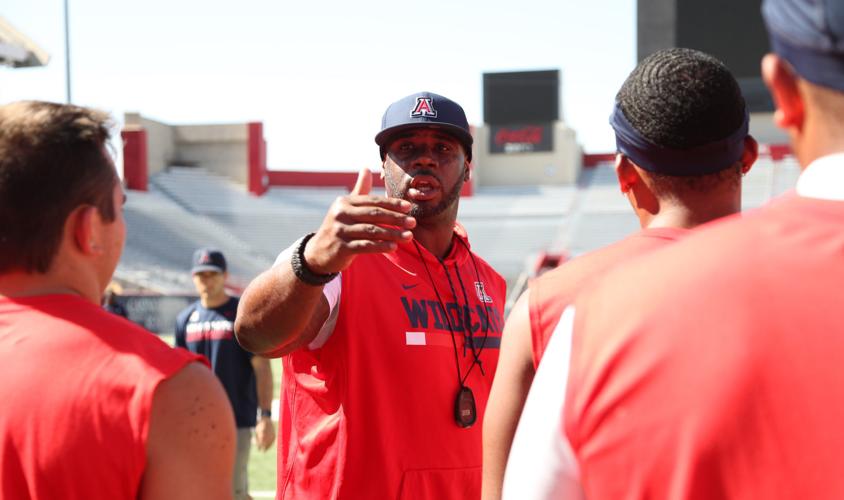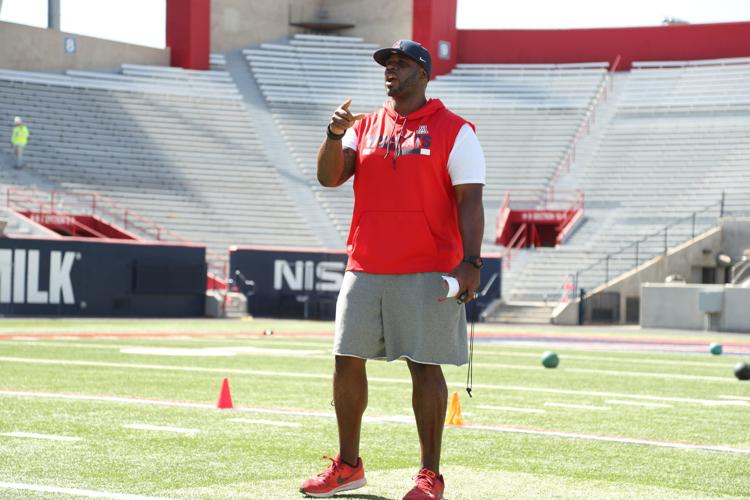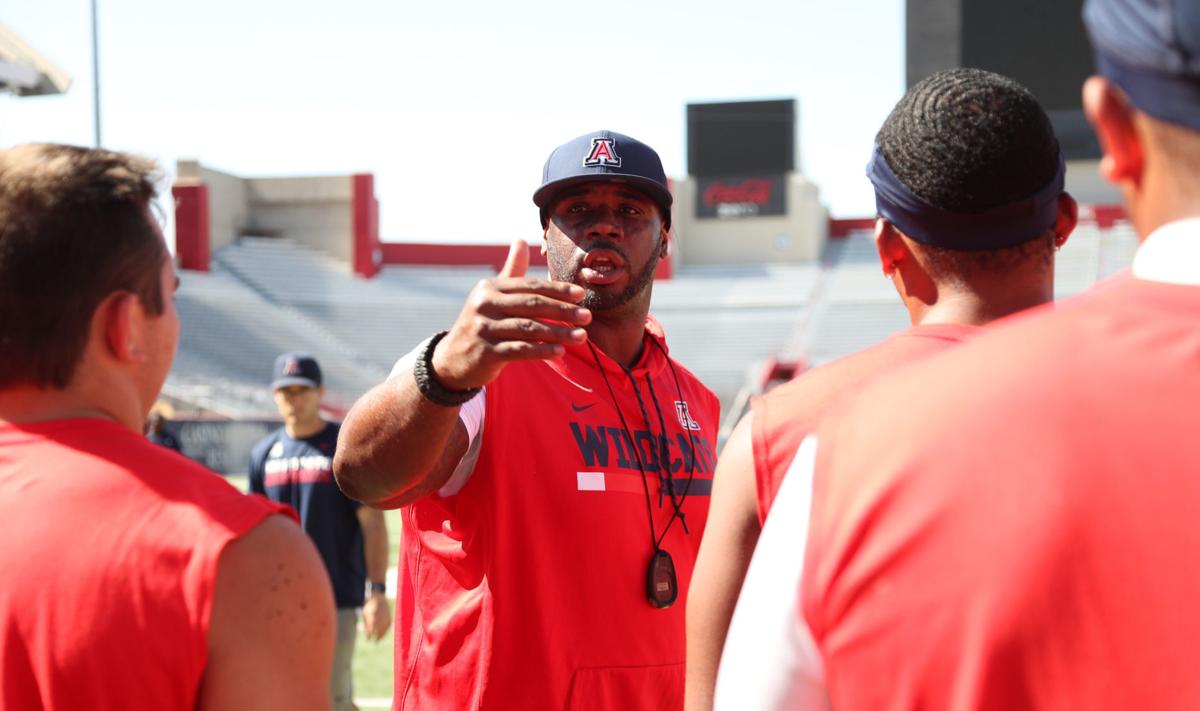No time is more important for a college football team than right now. No person has a bigger influence on the players during this critical period than the strength and conditioning coach.
“Summer is my in-season,” said Brian Johnson, the first-year director of strength and conditioning for the Arizona Wildcats. “This is it. Championship’s won in the summer.”
Johnson knows what it’s like to win one. He played for the 2003 LSU team that shared the national title.
After a playing career cut short by injury, Johnson segued into strength and conditioning. He played and worked for many high-profile figures along the way, including Nick Saban, Les Miles and Chip Kelly. Kevin Sumlin needed only one season with Johnson at Texas A&M to realize he could entrust him with the vital task of getting the Wildcats into tiptop shape.
It has taken Johnson just a few months to galvanize a new batch of players in Tucson.
“He’s been all in ever since he got here,” senior safety Demetrius Flannigan-Fowles said. “He gave us the blueprint — told us what he wanted to do and how he wanted to do it. Since then, we’ve just been working.”
Flannigan-Fowles recalled the first time the team met Johnson, back in February. The former offensive lineman cuts an imposing figure, his chest thick, his shoulders broad.
“He’s a real big guy, so everybody’s going to sit up in their chairs,” Flannigan-Fowles said. “He gave us a rundown. He gave us what he wanted to do. He had a plan.”

Brian Johnson of the University of Arizona football team.
Coaches are allowed to spend eight hours a week with the players during the offseason. Only two of those can be used for “individualized skill instruction.” The remainder are spent on strength and conditioning activities.
Johnson and his staff spend 90 minutes apiece, four days a week, with multiple position groups from early June through late July. They run on the sizzling turf of Arizona Stadium and lift in the air-conditioned weight room of Lowell-Stevens Football Facility. It’s the time and place to lay the foundation for the grueling season to come.
“I have come into a great group of young men who are ready to work,” Johnson said. “They want to win, and they believe in what we’re doing. The buy-in has been great. The effort has been great from everybody.
“We’re still getting where we want to; obviously, we’re not there yet. If there’s ever a time we feel like we are there, then we’re in trouble.”
Step by step
Johnson is hosting a visitor in his modest but well-placed office on the loft level of the weight room. To his right, he has a view of Bear Down Field. To his left, he can see all the activity below — players lifting, grunting, sweating and grinding.
Pictures of Johnson’s family — wife Angela, son Deacon, 2, and daughter Chandler, 1 — are tacked to the wall over his right shoulder, a symbol of the time that has passed since his coaching journey began.
Johnson started 28 games at multiple line positions for LSU from 2003-06, playing for Saban and Miles. Despite accumulating 148 knockdowns and 34 pancake blocks over his final two seasons, Johnson did not get drafted.
Johnson spent the next three years in the NFL with the Cardinals, Buccaneers and Ravens, although he never played in a regular-season game. The final season was spent on injured reserve after Johnson required back surgery, a byproduct of the pounding he endured while toiling in the trenches.
“That back experience was a pretty painful deal,” said Johnson, who battled depression and anxiety during that time. “From being in peak physical shape to now laying in a bed for a month was hard mentally to deal with.”
It was a dark time for Johnson, but also a contemplative period. And, ultimately, a turning point.
Still in his mid-20s, Johnson had to decide whether to keep trying to play or do something else with his life. After concluding his post-surgery rehab, Johnson returned to his hometown of Tallahassee, Florida, where he visited with his old offensive coordinator at LSU, Jimbo Fisher, who had become the head coach at Florida State. (In December 2017, Fisher succeeded Sumlin at Texas A&M.)
Johnson enjoyed being around familiar faces at the football facility — “It was just a good place for me to be every day,” he said – and Fisher presented him with an opportunity to join the Seminoles’ strength and conditioning staff.
Single at the time, Johnson worked long hours and made $19,000 a year with no benefits. He realized he had found his calling.
“Immediately I knew this was what I was supposed to be doing,” Johnson, 34, said. “It helped the transition from ‘Man, I’m not playing football anymore’ to ‘I still have an impact. I’m still part of a football organization.’
“It’s just a different impact now. Now I’m helping young men get to a point where I was in my career, and hopefully to do better, to get drafted.”
Johnson spent two-plus years as an assistant at FSU before becoming the head strength coach at Akron. Johnson quickly realized he wasn’t ready for that job. He needed to learn more about the science behind strength and conditioning, as well as the administrative and organizational components of the position.
“I had aspirations of winning national championships and being one of the best to ever do this,” Johnson said. But he needed more grooming.
Four months later, Johnson returned to LSU, his alma mater, where he spent three seasons as an assistant under longtime strength and conditioning coach Tommy Moffitt. Then came a two-year stretch with the San Francisco 49ers, where Johnson worked for Mark Uyeyama, now the head strength coach for the Minnesota Vikings.
After the 49ers fired Kelly, Johnson joined the staff at A&M. Despite the post he briefly held at Akron, Johnson considers his current job his first real chance to run a program.
“All these steps prepared me for this,” he said.
Putting in the work
On workdays, Johnson sets his alarm for 4:10 a.m. But he typically wakes up between 3:45 and 4. “Just anxious to get here and make sure everything’s right and ready to run for the day,” he said.
Johnson usually gets to campus by 4:45 to work out. At 6 a.m., the “developmental squad” — the newly arrived freshmen — begins its workout. Three other groups follow: receivers and defensive backs from 7-8:30 a.m.; “big skill” (quarterbacks, running backs, tight ends, linebackers and special-teamers) from 9-10:30; and offensive and defensive linemen from 11-12:30 p.m. The freshmen return at 1:30 to lift.
That’s the basic routine on Monday, Tuesday, Thursday and Friday; Wednesday, Saturday and Sunday are recovery days. But it isn’t the same for everyone. Johnson and his staff cater their program to the specific needs of positions and players. It’s no coincidence that the receivers and DBs — many of whom are trying to bulk up — work out early in the morning, when it’s cooler, while the linemen — many of whom are trying to trim down — go later, when it’s hotter.
While the veterans combine their running and lifting into one session, it’s broken up for the newcomers, whose physical condition is still being evaluated.
“I’ve never seen them before,” Johnson said. “I don’t know what they’ve done. Are there any pre-existing injuries? I don’t know what kind of strength and conditioning program that kid had in high school. The last thing I want is a setback.”
Johnson learned the importance of paying attention to details and of having a daily work ethic from Saban. Two examples of the former: Staffers deliver bottles of water to the players when they arrive for workouts to set the tone for proper hydration in the Arizona heat; and players’ running form is emphasized and analyzed to guard against soft-tissue injuries.
From the forward-thinking Kelly, Johnson learned the value of collecting data, of evaluating players throughout the day and of individualizing training programs as much as possible.
Johnson and his staff have been working to increase the strength and power in Flannigan-Fowles’ legs; he has gained 5 pounds since last season and reports that he never has been more explosive.
Senior Shawn Poindexter has added 10 pounds; the 6-5 receiver now checks in at 218. He isn’t lifting more weight than before, but he’s working out more efficiently.
“You play within your base,” Poindexter said. “We’re not getting outside of our base.”
So far, the regimen Johnson and his staff have designed for Poindexter is working the way it’s supposed to — he feels stronger and faster.
“I can see a change in my body,” Poindexter said. “I’m a stronger player because of the program. They push us to get better every single day.”






